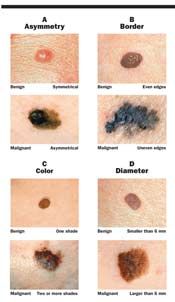The ABCDEs of moles and melanomas
Concept and photographs:The Skin Cancer Foundation, www.skincancer.org
The ABCDEs

of moles and melanomas
Concept and photographs:
The Skin Cancer Foundation, www.skincancer.org
People at high risk of developing melanoma are those who have:
• A family history of melanoma, or who have had a melanoma in the past
• Unusual moles on the skin, or changing moles
• Fair skin, light hair and eye color, and who sunburn easily or tan with difficulty
• A record of painful or blistering sunburns as children or in their teenage years
• Indoor occupations and outdoor recreational habits
When you inspect moles, pay special attention to their sizes, shapes, edges, and color. A handy way to remember these features is to think of the A, B, C, D, and E of skin cancer-asymmetry, border, color, diameter, and

evolving.
Asymmetry: If you draw a line through an asymmetrical mole, the two halves will not match.
Border: The borders of an early melanoma tend to be uneven. The edges may be scalloped or notched.
Color: Having a variety of colors is another warning signal. A number of different shades of brown, tan or black could appear. A melanoma may also become red, blue, or some other color.
Diameter: Melanomas usually are larger in diameter than the size of the eraser on your pencil (1/4 inch or 6 mm), but they may sometimes be smaller when first detected.
Evolving: Any change in a mole - in size, shape, color, elevation, or another trait, or any new symptom such as bleeding, itching, or crusting - points to suspicion and possible danger.
Newsletter
Stay up to date on recent advances in the multidisciplinary approach to cancer.